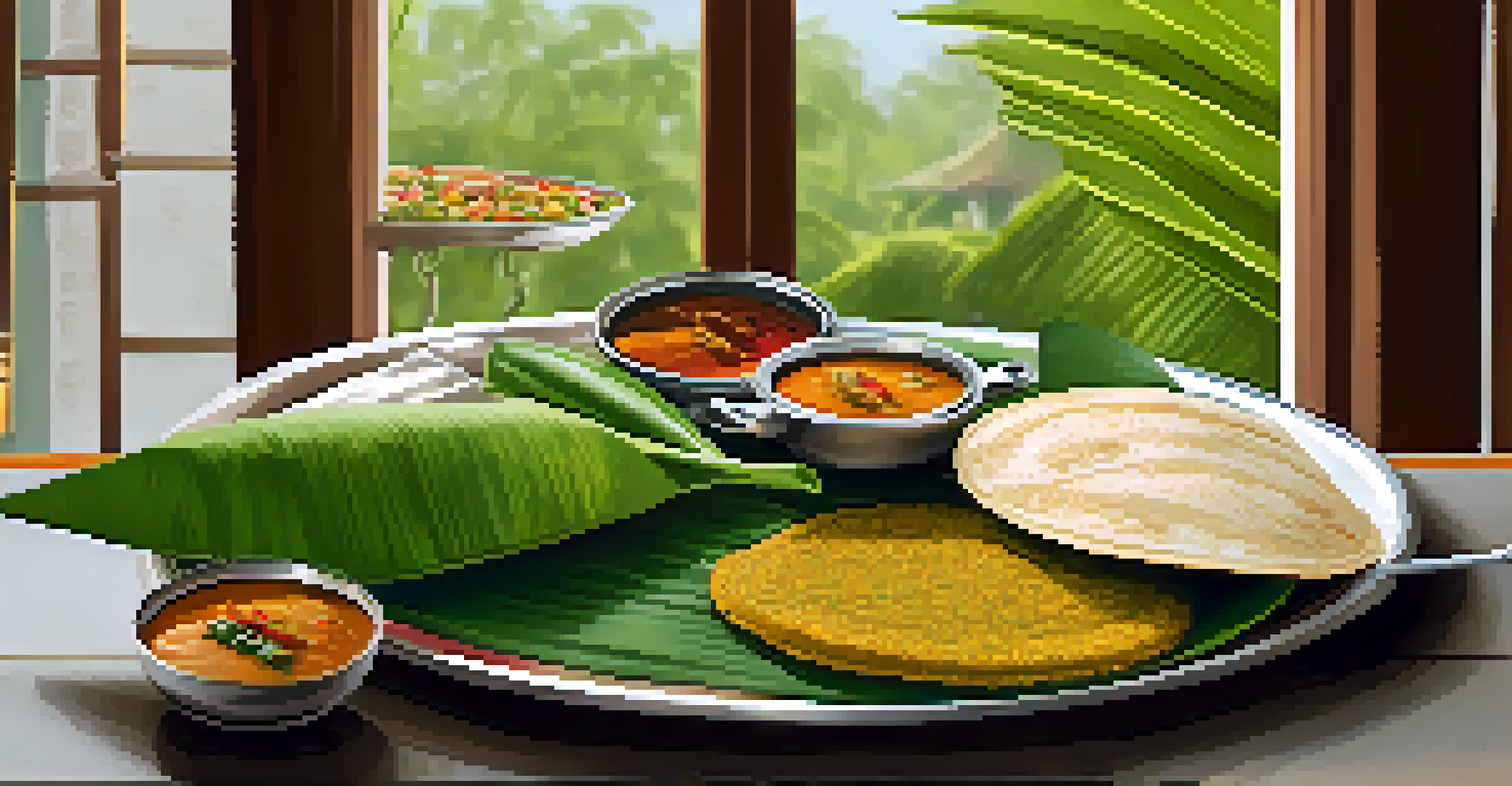Exploring Regional Cuisines: A Culinary Tour of India

Introduction to India's Culinary Diversity
India is a land of vibrant cultures, and its cuisine reflects this diversity. Each region offers unique flavors, ingredients, and cooking techniques, making Indian food an exciting journey for the palate. From the rich, spicy dishes of the South to the aromatic curries of the North, there's something for everyone to enjoy.
Food is our common ground, a universal experience.
Understanding regional cuisines is like peeling back the layers of an onion; each layer reveals a new flavor and story. The culinary traditions are often tied to local geography, climate, and history, giving each dish a unique context. For instance, coastal areas like Goa thrive on seafood, while the arid deserts of Rajasthan focus on preserving ingredients.
As we embark on this culinary tour, get ready to explore the different regions of India, each promising a feast of flavors that tells a story of its own.
North Indian Cuisine: A Flavorful Heritage
North Indian cuisine is known for its rich, creamy dishes that often feature dairy, wheat, and an array of spices. Dishes like butter chicken and paneer tikka are staples that have gained popularity worldwide, showcasing the region's love for robust flavors. The use of tandoors, or clay ovens, adds a unique smoky taste to many dishes, making them unforgettable.

Street food in cities like Delhi and Amritsar offers a delightful glimpse into everyday North Indian fare. From chaat, a tangy snack, to parathas stuffed with various fillings, street vendors serve up local favorites that are both affordable and delicious. It’s a culinary adventure that invites people to connect over food.
India's Culinary Diversity Explored
Each region of India offers a unique culinary experience, showcasing diverse flavors, ingredients, and cooking traditions.
Festivals also play a significant role in North Indian cuisine, with special dishes prepared for celebrations. Whether it's biryani for Eid or sweets for Diwali, these culinary traditions strengthen community bonds and preserve cultural heritage.
South Indian Cuisine: A Symphony of Flavors
South Indian cuisine is celebrated for its use of rice, lentils, and fresh vegetables, often resulting in lighter, healthier dishes. The staple dosa, a fermented crepe made from rice and lentils, is commonly served with various chutneys and sambar, a lentil-based vegetable stew. These dishes are not only tasty but also rich in nutrition.
The discovery of a new dish does more for the happiness of mankind than the discovery of a star.
The coastal regions contribute a wealth of seafood dishes, featuring ingredients like coconut and tamarind that add a distinct flavor profile. Whether it’s the spicy fish curry of Kerala or the tangy prawn masala of Andhra Pradesh, each dish reflects the region's natural bounty. This cuisine is a testament to the harmony between food and environment.
Moreover, South Indian meals are often served on a banana leaf, creating an immersive dining experience. This practice goes beyond aesthetics; it also enhances the flavors and is eco-friendly. Eating with your hands is encouraged, connecting you more intimately with the food.
West Indian Cuisine: A Spice Lover's Paradise
West Indian cuisine is a vibrant tapestry of flavors, characterized by the liberal use of spices and herbs. From the fiery curries of Maharashtra to the sweet and spicy dishes of Gujarat, there's a world of taste waiting to be explored. The combination of flavors in dishes like dhokla and pav bhaji highlights the creativity of the region's chefs.
The state of Goa adds an exciting twist with its unique fusion of Indian and Portuguese influences. Dishes like vindaloo and xacuti showcase a blend of spices that create a depth of flavor that is simply irresistible. Goa’s culinary scene is a celebration of seafood, often cooked with coconut milk and zestful spices.
Street Food Celebrates Local Culture
Street food across India provides a delightful glimpse into everyday life, inviting connections through affordable and delicious local fare.
Street food in this region is equally enticing, with stalls serving up everything from vada pav to bhel puri. These snacks are not just meals; they're a cultural experience that invites you to savor the local lifestyle and flavors. The bustling markets and vibrant stalls are the heart of West Indian culinary culture.
East Indian Cuisine: A Sweet and Savory Delight
East Indian cuisine is often regarded for its delicate balance of flavors, where sweet meets savory in exquisite harmony. Rice is the staple here, accompanied by fresh fish, vegetables, and an array of spices. Dishes like macher jhol, a fish curry, are a testament to the region's affinity for fresh ingredients.
The culinary traditions of West Bengal are particularly famous for their sweets, such as rasgulla and sandesh, which are made from fresh cheese and often flavored with fruits. These desserts highlight the region's love for sweets, making it a paradise for dessert lovers. Festivals like Durga Puja showcase elaborate feasts, celebrating this sweet tooth.
Moreover, the use of mustard oil and panch phoron, a five-spice blend, adds a distinctive touch to many dishes. This unique flavor profile sets East Indian cuisine apart, making it a delightful experience for those exploring its culinary landscape.
Northeast Indian Cuisine: A Hidden Gem
Northeast Indian cuisine is often overlooked but offers a treasure trove of unique flavors and dishes. Ingredients like bamboo shoot, fermented foods, and local herbs dominate the culinary scene, creating a distinctive taste that sets it apart from the rest of India. Dishes such as bamboo shoot curry and smoked pork with bamboo are showcases of this region’s rich food culture.
Each state in the Northeast boasts its own culinary traditions, influenced by local tribes and communities. For example, the cuisine of Nagaland is known for its use of fresh produce and meat, often prepared in simple yet flavorful ways. This connection to nature gives the food an authenticity that is hard to replicate.
Food as a Reflection of Community
Culinary traditions in India often emphasize communal dining, highlighting the importance of food in bringing people together.
Moreover, the region's emphasis on community and sharing is reflected in its dining practices. Meals are often communal, bringing people together to enjoy the fruits of their labor. This sense of togetherness is a testament to the importance of food in fostering relationships.
Conclusion: A Culinary Journey Worth Taking
Exploring the regional cuisines of India is not just about tasting different dishes; it’s about immersing yourself in a rich tapestry of culture, history, and tradition. Each region tells its own story through food, offering insights into local lifestyles and values. This culinary journey is an invitation to broaden your palate and deepen your appreciation for diverse flavors.
With every bite, you experience the passion and creativity that go into crafting each dish, from the bustling kitchens of street vendors to the sophisticated recipes passed down through generations. Embracing these culinary traditions can open your mind and heart to the beauty of diversity.

So, whether you're a seasoned foodie or a curious beginner, exploring India's regional cuisines promises an adventure filled with delightful surprises and unforgettable memories. Ready your taste buds for a journey like no other!